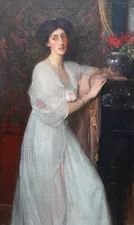George Spencer Watson ROI, ARA, RA (1869-1934)
George Spencer Watson, ROI, RP, ARA, RA (1869-1934) Born in London the son of a surgeon, George Spencer Watson trained as an artist at St. John's Wood and The Royal Academy Schools from 1889. He was an English portrait artist of the late romantic school who sometimes worked in the style of the Italian Renaissance. Exhibiting at the RA from 1891, George Spencer Watson's best Edwardian portraits show a controlled aestheticism and display the influence of John Singer Sargent. Although his earlier preference had been to paint subject pictures in the tradition of Lord Leighton and George Frederick Watts, Spencer Watson's later success as a society portraitist led to a steady stream of commissions. After 1900 Spencer Watson began exhibiting regularly at The Royal Academy, at The New Gallery and at The Society of Portrait painters of which he became an active member. Until the First World War he also exhibited at the Paris Salon regularly until the 1914 War, and he had a one man touring show in 1912. In 1909 he married Hilda Mary Gardiner, a dancer and mime artist, and follower of the actor Edward Gordon Craig. They had a daughter, Mary Spencer Watson (1913–2006), who became a sculptor. In the year of 1923 he bought Dunshay Manor in the hills of the Isle of Purbeck, after already having spent holidays in nearby Swanage. He died in London at age 65 and a memorial exhibition was held at the Fine Art Society in the same year. There is a memorial to him in the north vestibule of St James's Church, Piccadilly. Some of his works are held at Tate Britain, the Harris Art Gallery, Preston and collections in Bournemouth, Liverpool, Plymouth and the National Gallery of Canada. Born in London, Watson studied at the Royal Academy from 1889; he exhibited there from 1891 and also at the Paris salon. Retrospective exhibitions were held at the Galerie Heinemann, Munich in 1912, and at the Fine Art Society in 1914. His work A Lady in Black (1922) is owned by the Tate Collection.


